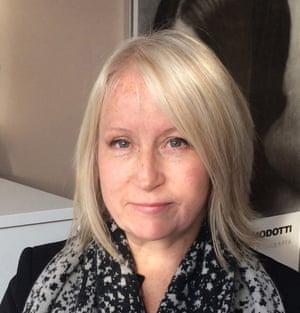The children kept asking the attendant: Are the bears alive or dead?
I have always been interested in childhood and play, that unguarded space of imagination and reverie that children access so easily. In the 1990s, I started thinking about how children were engaging with gaming and the internet, which were still embryonic. So when I moved back to Edinburgh from London, I set about exploring how digital learning was being used in schools.
The more time I spent in schools, the more I saw what children were actually doing. One of those things was museum visits and it was clear that digital culture was greatly affecting museums too. So I spent a year trailing school parties taking guided tours around the Royal Museums of Scotland. I would secrete myself in a corner with my lights this was in the days before cordless equipment and shoot large groups quickly, then in post-production isolate single children. Here, you can see a split reflection of two girls in the vitrine, but only one of them actually looking.
The memories you have of going to a museum are not of your classmates, they are of the objects. I remember the children speaking to the guards, often asking them: Is it alive or is it dead? They were five or six years old. The guard would hesitate, saying: Well, it was alive and now its dead. I can relate to that sense of anxiety. Even now at the zoo, if Im standing too close to the lion enclosure, I feel nervous. It just appears too open, even though you know the animals cannot get out.
The vitrines became a really important part of all the images. This one was an amazing display case in a Victorian gallery, with a glass cupola that gave beautiful overhead light. I remember visiting it myself as a child. On the other side of the bears, there was a Bengal tiger. We would line up to sit down on our little padded seats, inches away from this huge creature. Being in such close proximity to something like that was a strange, memorable experience. And that individual experience is what I wanted to capture: a child engaging with something much larger than itself.
These Victorian displays and dioramas were often quite ferocious and bloody, with animals ripping out each others gizzards. That kind of containment of emotion or feeling is a gift for a photographer.
The children loved the bears and the birds most. Theres another image of an owl swooping on a taxidermied mouse with a little boy looking out to the camera in front of the case. And another of an impossibly huge albatross in a beautiful sculpted case. The images that worked best were those that played with scale: a very small child engaging with a very large object.
I was thinking about childrens engagement with the outside world, especially in the face of the rapidly evolving culture of gaming and the screen. When I was that age, the museum was the place where everything important was held. Now with the internet, that is very different. If a child wants to learn about something, they dont naturally go to the museum. They go online.
This gallery no longer exists. Some of the objects have been brought out, cleaned up and displayed elsewhere, freed from the glass cases. Going back 20 years on, its like seeing old friends.
Wendy McMurdo is in the group show In Focus: Scottish Photography at City Art Centre which is part of this years Edinburgh Art Festival until 26 August

Born: Edinburgh, 1962.
Training: Edinburgh College of Art, Pratt Institute, Goldsmiths, University of London.
Influences: Lee Miller, Man Ray, Susan Hiller, Marina Warner, Sarah Charlesworth, Valrie Belin, Martin Scorsese, Michael Powell and Emeric Pressburger.
High point: Having my first British Council touring show and beginning to see the work go out into the world. Being able to travel widely was really important at that time.
Low point: When my kids were young, having to sell off all of my camera equipment that wasnt absolutely essential to keep the studio work going a high point was buying most of it back, years later.
Tip: Read widely, look carefully, keep your overheads low and keep going.
Read more: http://www.theguardian.com/us

